

Blues. Easy listening. Easy listening music is often confused with so-called elevator music provided by Muzak Holdings and other music services for malls and elevators, or lounge music, but while it was popular in some of the same venues it bore only modest resemblance to the background sound of this kind of music.
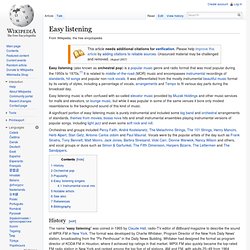
A significant portion of easy listening music is purely instrumental and included some big band and orchestral arrangements of standards, themes from movies, bossa nova hits and small instrumental ensembles playing instrumental versions of popular songs, including light jazz and even some soft rock and roll. History[edit] A precursor to Easy Listening initially offered soft and unobtrusive instrumental selections on a very structured schedule with limited commercial interruptions. It often functioned as a free background music service for stores, with commercial breaks consisting only of announcements aimed at shoppers already in the stores.
Orchestral pop[edit] Popularity[edit] Notable artists[edit] Spiritual (music) Spirituals (or Negro spirituals[1][2][3][4][5][6]) are religious (generally Christian) songs that were created by enslaved African people in the United States.
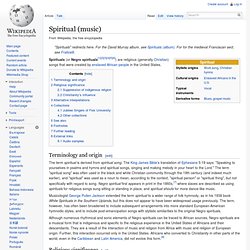
The term spiritual is derived from spiritual song. The King James Bible's translation of Ephesians 5:19 says: "Speaking to yourselves in psalms and hymns and spiritual songs, singing and making melody in your heart to the Lord. " The term "spiritual song" was often used in the black and white Christian community through the 19th century (and indeed much earlier), and "spiritual" was used as a noun to mean, according to the context, "spiritual person" or "spiritual thing", but not specifically with regard to song. Negro spiritual first appears in print in the 1860s,[7] where slaves are described as using spirituals for religious songs sung sitting or standing in place, and spiritual shouts for more dance-like music.
Negro spirituals were primarily expressions of religious faith. There is also a duality in the lyrics of spirituals. Gospel. Gospel music is a music genre.
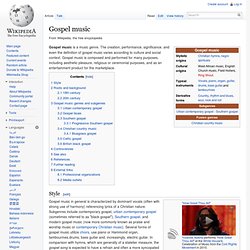
The creation, performance, significance, and even the definition of gospel music varies according to culture and social context. Gospel music is composed and performed for many purposes, including aesthetic pleasure, religious or ceremonial purposes, and as an entertainment product for the marketplace. Style[edit] Gospel music in general is characterized by dominant vocals (often with strong use of harmony) referencing lyrics of a Christian nature.
Ragtime. Second edition cover of "Maple Leaf Rag.
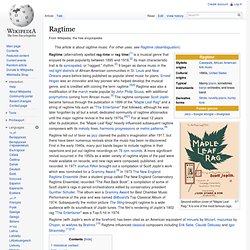
" It is one of the most famous rags. Ragtime (with Joplin's work at the forefront) has been cited as an American equivalent of minuets by Mozart, mazurkas by Chopin, or waltzes by Brahms.[10] Ragtime influenced classical composers including Erik Satie, Claude Debussy and Igor Stravinsky.[11][12] Historical context[edit] Ragtime originated in African American music in the late 19th century, descending from the jigs and march music played by black bands.[13] By the start of the 20th century, it became widely popular throughout North America and was listened and danced to, performed, and written by people of many different subcultures.
A distinctly American musical style, ragtime may be considered a synthesis of African syncopation and European classical music, especially the marches made popular by John Philip Sousa. The emergence of mature ragtime is usually dated to 1897, the year in which several important early rags were published. Scott Joplin. Country. Early origins[edit] Ryman Auditorium, the "Mother Church of Country Music" Immigrants to the Southern Appalachian Mountains of North America brought the music and instruments of the Old World along with them for nearly 300 years.
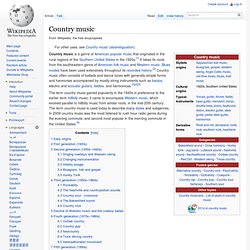
They brought some of their most important valuables with them, and to most of them this was an instrument: "Early Irish settlers enjoyed the fiddle because it could be played to sound sad and mournful or bright and bouncy.
Western Swing. Ragtime. Jazz. JAZZ. Swing. History[edit] 1920s: Origins[edit] Like jazz, swing was created by African Americans, and its impact on the overall American culture was such that it marked and named an entire era of the USA, the swing era – as the 1920s had been termed "The Jazz Age".[1] Such an influence from the black community was unprecedented in any western country.[1] Swing music abandoned the string orchestra and used simpler, "edgier" arrangements that emphasized horns and wind instruments and improvised melodies.
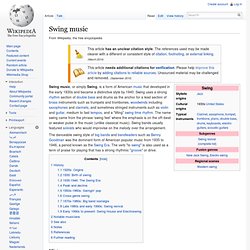
Louis Armstrong shared a different version of the history of swing during a nationwide broadcast of the Bing Crosby (radio) Show.[2] Crosby said, "We have as our guest the master of swing and I'm going to get him to tell you what swing music is. " Armstrong said, "Ah, swing, well, we used to call it syncopation — then they called it ragtime, then blues — then jazz. Big Band. A big band is a type of musical ensemble that originated in the United States and is associated with jazz and the Swing Era typically consisting of rhythm, brass, and woodwind instruments totaling approximately 12 to 25 musicians.
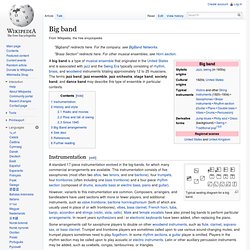
The terms jazz band, jazz ensemble, jazz orchestra, stage band, society band, and dance band may describe this type of ensemble in particular contexts. Instrumentation[edit] Typical seating diagram for a big band. A standard 17-piece instrumentation evolved in the big-bands, for which many commercial arrangements are available. Western Swing. This article is about the musical subgenre.
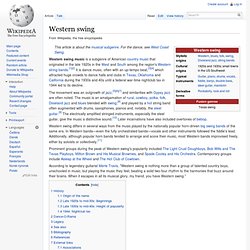
For the dance, see West Coast Swing. Western swing differs in several ways from the music played by the nationally popular horn-driven big swing bands of the same era. In Western bands—even the fully orchestrated bands—vocals and other instruments followed the fiddle's lead. Appalachian. Bog Trotters Band (a string band); Galax, Va. 1937; Dr.
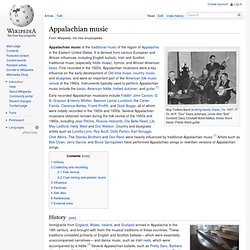
W.P.